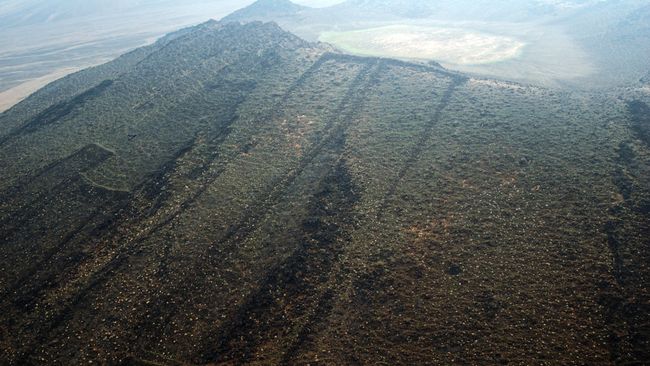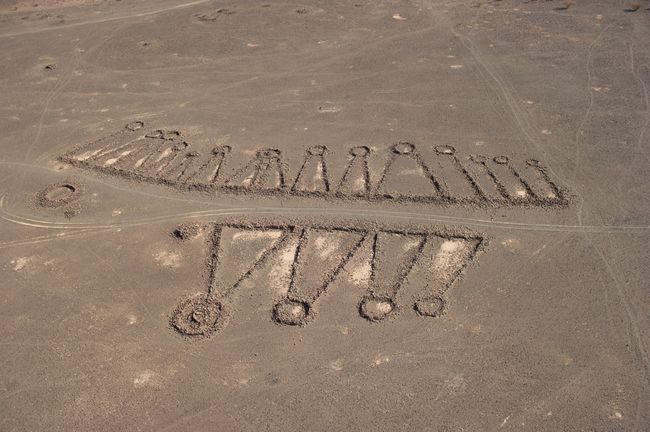Anthropology
Related: About this forumMassive stone structures in Saudi Arabia may be some of oldest monuments in the world
By Owen Jarus - Live Science Contributor an hour ago
They number in the hundreds and can be larger than an NFL football field.

Mustatils have been found in a wide variety of environments in Saudi Arabia including six examples
seen here on the slope of a volcano.
(Image: © Gary Rollefson)
They number in the hundreds, can be larger than an NFL football field and are found across Saudi Arabia, including on the slope of a volcano. Sprawling stone structures reported in 2017 now appear to be some of the oldest monuments in the world, dating back some 7,000 years, archaeologists now report.
A new study of the mysterious stone structures — once called "gates" but now referred to as "mustatils," the Arabic word for "rectangle" —suggests they were used for rituals; and radiocarbon dating of charcoal found within one of the structures indicates people built it around 5000 B.C., a team of researchers report in an article recently published in the journal The Holocene.
Related: See photos of the mysterious stone structures in Saudi Arabia
"The mustatil phenomenon represents a remarkable development of monumental architecture, as hundreds of these structures were built in northwest Arabia," the researchers wrote in their paper. "This 'monumental landscape' represents one of the earliest large-scale forms of monumental stone structure construction anywhere in the world."
Ritual use
The structures are made from low stone walls that form what often looks like a field gate from above (hence their former name). They range in size with some measuring less than 49 feet (15 m) long and the largest measuring about 2,021 feet (616 m) long.
More:
https://www.livescience.com/mysterious-stone-structures-saudi-arabia-oldest.html?utm_source=notification
UpInArms
(53,539 posts)A part of me wonders if they were animal pens ...
Judi Lynn
(163,980 posts)Judi Lynn
(163,980 posts)The White Volcanoes of Harrat Khaybar
KAUSHIK PATOWARY OCT 25, 2019
Of the millions of pilgrims that visit the holy city of Medina, in Saudi Arabia, every year to pray in the Prophet’s Mosque, few people are aware that the city is build upon the basalt flows of a past volcano, with the now dormant volcano lying very close to the city. This volcanic field, known as Harrat Khaybar, contains some of the rarest examples of white volcanoes, so called because of their light colored rocks caused by the presence of a kind of alkali and silica-rich light blue-gray igneous rock called comendite.

An aerial view of the Jebel Bayda, a white volcano made by silica-rich lava (comendite) in Harrat Khaybar. Photo credit: Luigi Vigliotti
This uncommon type of lava was first discovered in Queensland Australia in the Glass House mountains, although it has also turned up in Sardinia, Corsica, Ascension Island, Ethiopia, Somalia and few other areas of East Africa.
The Harrat Khaybar volcano is one of Arabia's largest volcanic fields and covers more than 14,000 square km. The volcanic field was formed by eruptions along a 100-kilometer, north-south vent system over the past 5 million years. The most recent recorded eruption took place between 600–700 AD.
Harrat Khaybar contains a wide range of volcanic rock types and spectacular landforms, as represented in the photograph below. The image was taken by the Expedition 16 crew aboard the International Space Station in March 2008.

The symmetric structures are tuff cones, formed by eruption of lava in the presence of water. The combination produces wet, sticky pyroclastic deposits that can build a steep cone structure, particularly if the deposits consolidate quickly. The presence of these tuff cones indicate that the local climate was much wetter during some periods of volcanic activity. Today, this region is as dry as bone with little to no yearly precipitation leading to an almost total lack of vegetation.
https://www.amusingplanet.com/2019/10/white-volcanoes-of-harrat-khaybar.html
Judi Lynn
(163,980 posts)VIEW SLIDESHOW
Professor David Kennedy of the University of Oxford just discovered hundreds of mysterious structures near ancient lava domes in Saudi Arabia. Using Google Earth, Kennedy found approximately 400 stone walls that are believed to be more than 9,000 years old. Because the structures appear similar to others found in the Middle East, they have been dubbed “gates”

More:
https://inhabitat.com/hundreds-of-mysterious-stone-structures-discovered-near-ancient-volcanoes-in-saudi-arabia/
~ ~ ~
Older article:
Aerial Images May Unlock Enigma of Ancient Stone Structures in Saudi Arabia
By David Kennedy November 12, 2017

Aerial photographs and ground inspection of the keyhole pendants in Saudi Arabia reveal more details of the enigmatic structures.
(Image: © Courtesy APAAME, APAAME_20171027_DLK-0891)
Hundreds of thousands of stone structures that date back thousands of years and dot the deserts and plains of the Middle East and North Africa are, in many cases, so large that only a bird's-eye view can reveal their intricate archaeological secrets: gorgeous and mysterious geometric shapes resembling a range of objects, from field gates, to kites, to pendants, to wheels.
These are the "Works of the Old Men," according to the Bedouin when first questioned in the 1920s. And although ancient peoples evidently had their reasons for constructing these stone structures, their purpose has remained relatively opaque to archaeologists today.
I have been studying these Works for two decades, and their inaccessibility has made these sites' purposes even more elusive. That's where satellite imagery (used by Google Earth) and aerial reconnaissance, which involves much lower-flying aircraft) come in.
In the past few weeks, a huge opportunity opened up in this field after Live Science published an article about my research, sparking a deluge of international media coverage. Ultimately, I was invited to visit the country that has been least open to any form of aerial surveys, or even to archival aerial images: Saudi Arabia. Last month, they lifted this veil of sorts and allowed me to fly over the country's vast array of archaeological sites for the first time. [See Spectacular Images of the Stone Structures of Saudi Arabia]
More:
https://www.livescience.com/60918-aerial-images-reveal-saudi-arabia-stone-structures.html
Judi Lynn
(163,980 posts)BY CALLUM PATON ON 11/15/17 AT 12:31 PM EST
Images taken from a helicopter flying at low altitude have shown in never-before-seen detail the mysterious neolithic structures dubbed the Saudi Arabian "Gates of Hell" and may shed more light on archaeological treasures yet to be uncovered in the Gulf kingdom.
The hundreds of 9,000-year-old structures initially baffled experts when they were seen in satellite imagery. The Stone Age walls, found built in volcanic fields in Saudi Arabia's remote Harrat Khaybar region, were named the Gates Of Hell because their short, thick connecting piles of brick resembled barred gates when viewed from above.
Related: Ancient Egyptian Mummy Buried Wearing Golden Sky God Mask Discovered In Long-Lost Sarcophagus
As well as the gate-like structures, archaeologists also identified a series of ancient walls that resembled kite shapes and round constructions that have been referred to as both wheels and bullseyes.
While the stone creations were known for generations by local bedouin tribes as "works of the old men," they were first documented in the Western archaeological community by David Kennedy from the University of Western Australia who has identified around 400 stone walls.
Kennedy's interest in the potential for archaeological discovery in the region began in the late 1960s, when he traveled through the area. A decade later, he set up the Aerial Photographic Archive for Archaeology in the Middle East—an initiative to map the area that now has more than 140,000 aerial images.
More:
https://www.newsweek.com/saudi-arabia-gates-hell-new-images-reveal-secrets-ancient-mystery-structures-712300